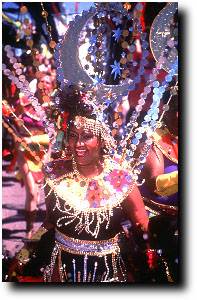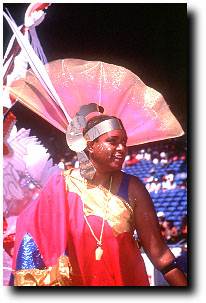A history lesson on Da Caribana
The Caribana festival celebrates its twenty-ninth anniversary in 1996. It has been an integral part of Toronto's multicultural heritage. From the
brilliant and dazzling costumes that add a myriad of colors to the city, to the pulsating rhythms of the steelbands and calypso music that entices the onlookers to participate, Caribana entertains and excites the hundreds of thousands of revellers. It draws young and old, black and white, Canadian and International visitor alike to witness that which is the Caribbean experience. The culmination of a year's planning and dedication of a small group of West Indian Canadians make Caribana North America's most spectacular showcase of Caribbean culture.
The festival is a reflection of the changing face of Toronto. No longer is this city dominated by a Catholic or Protestant white majority. Instead there is a mix of different cultures that consist of Chinese, East Indians, Africans and many other nationalities. They all contribute to make Toronto a true "Cultural Mosaic".
It is a festival that has grown from local interest to an international phenomenon. It has become as visible as other cultural events such as New Orleans' Mardi Gras. Caribana traces its beginnings to the West Indies and the Pre-Lenten Carnival in Trinidad. The origins of Carnival itself is a widely discussed subject. Some authors suggest that Carnival originated with the French colonists masquerades. "The white masters would paint their faces black and mock and mimic their slaves". Others have pointed to the similarities between Caribbean and West African forms of masquerade. Another theory states that Carnival appears to be related to earlier slave festivals such as Canboulay. Carnival is not the result of any one single cause, but instead is a merging of different experiences including the emancipation of slaves in 1834.

Caribana in Toronto has grown from a centenary celebration into a multi-million dollar enterprise. Along the way some of its goals have been changed and modernized. Battles over funding have been fought to keep the festival alive. Year after year through profit and loss, Caribana has brought together a fragmented West Indian community to share its culture.
The Birth of Caribana
In the summer of 1966 the Federal Government, in preparation for the upcoming Centenary commemorations, approached several prominent West Indian businessmen in Toronto to participate in the celebrations. The government wanted to exploit its multicultural policies by holding an event that would reflect the heritage of West Indians. It was intended to be a one-year event that would celebrate Canada's Centenary and tell Canadians that "we (West Indians) appreciated Canada". The results would be beyond expectations.
The first meeting was held in September 1966, at a firehall at Adelaide and University. This premier meeting was attended by approximately twenty people. they represented some of the West Indian intelligencia in Toronto.
The committee had to decide upon the appropriate time in which to hold the festival. The original Carnival in Trinidad is a Pre-Lenten festival, but organizers realized that it would be too cold in the February-March months in Canada. "The only time to have Carnival is when it is warm. We decided to pick a weekend where people wouldn't have to worry to get back home in a hurry. We picked the long weekend in August". Since that decision, the Caribana parade has always been on the long weekend in August.
The Caribana festival is in part a celebration of not only the African and West Indian history, but also a celebration of Canadian history. Its roots are in Trinidad but the other islands were well represented through many of the original organizers. It represents Canada's official commitment to multiculturalism.
It took ten months of planning, starting from September 1966 until the incorporation of the committee on July 28, 1967. This was only days before the opening of the first ever Caribana. While the Parade has become the focal point of all discussions, it was not the only event that took place in the inaugural year. The Caribana Festival of 1967 included many different activities. "Ferry cruises, beauty pageants, a grand ball, a Kiddie's Carnival and the spectacular parade, were all part of the first ever Caribana. Steel Bands and Calypso singers were brought up from the islands to lend authenticity to the proceedings and to entertain the eager crowds. It was a glorious week-long celebration of music, art and culture." Caribana '67 was an eight-day celebration of West Indian culture that centered around the August long weekend.

It began on July 30th and culminated on August 6th, 1967. The parade itself lasted for almost fourteen hours. The route in 1967 originated at Varsity Stadium on Bloor and went east to Yonge, south to Queen Street and then proceeded west on Queen to end at Nathan Phillips Square at Queen Street West and Bay Street. By 1968 the route had changed, It went from Varsity Stadium East, along Bloor to University past Queen's Park. The parade continued south on University Avenue to Queen Street West then continued west to Nathan Phillips Square.
The people who volunteered to assist in the festival numbered in the hundreds. There were five calypso and steel bands that were present for the parade. The five bands included over one thousand men, women and children "playing mas". (Toronto Star. 5 August 1967). Caribana attracted some 75,000 celebrants who lined the parade route to witness the extravaganza. It included people from all walks of life and not only members of the West Indian community.
The first two Caribana parades ended with the participants and onlookers congregating at the Toronto Islands across from the Harbourfront. The Toronto Island Ferries did not expect the surge of people that followed the parade. It was estimated that the 32,000 people went to the islands to continue the festivities.
Caribana continues to be Canada's biggest street festival, attracting over 1.5 million people, and contributing revenue in excess of one hundred and fifty million dollars.
If you have any questions email Tha Committee at [email protected]
Sign My Guestbook
 View My Guestbook
View My Guestbook